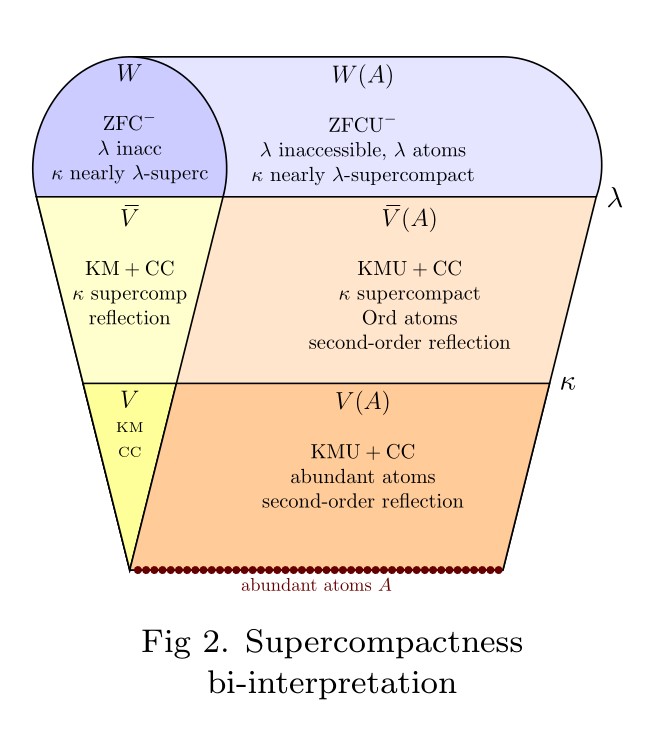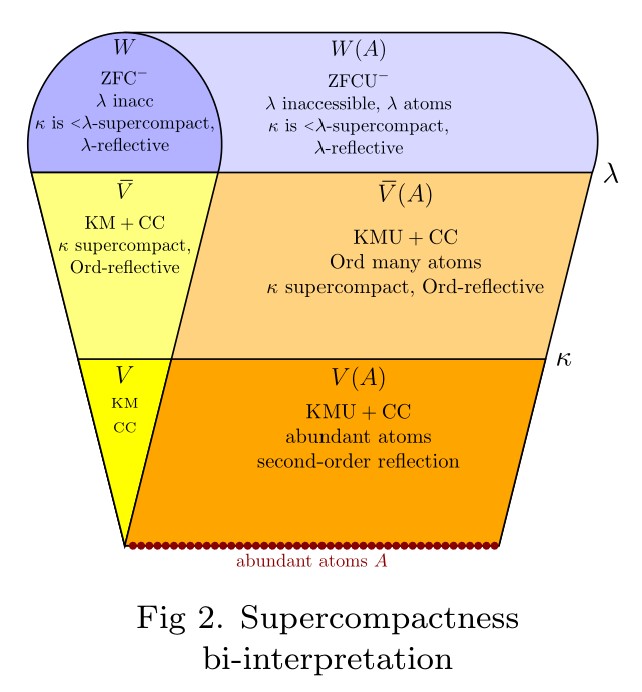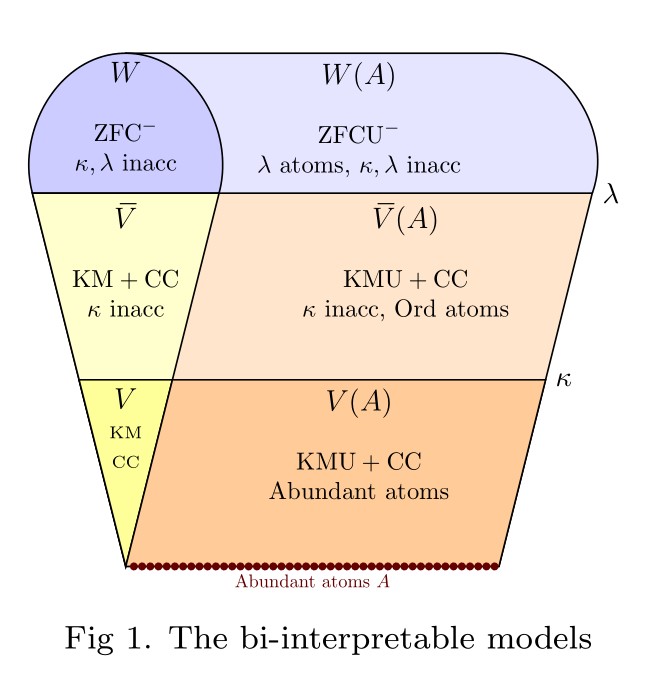$\newcommand\image{\mathrel{{}^{\prime\prime}}}$This post answers a question that had come up some time ago with Arthur Apter, and more recently with Philipp Schlicht and Arthur Apter.
Definition. A cardinal $\kappa$ is uniformly ${\lt}\theta$-supercompact if there is an embedding $j:V\to M$ having critical point $\kappa$, with $j(\kappa)>\theta$ and $M^{\lt\theta}\subset M$.
(Note: This is typically stronger than merely asserting that $\kappa$ is $\gamma$-supercompact for every $\gamma<\theta$, a property which is commonly denoted ${\lt}\theta$-supercompact, so I use the adjective “uniformly” to highlight the distinction.)
Two easy observations are in order. First, if $\theta$ is singular, then $\kappa$ is uniformly ${\lt}\theta$-supercompact if and only if $\kappa$ is $\theta$-supercompact, since the embedding $j:V\to M$ will have $j\image\lambda\in M$ for every $\lambda<\theta$, and we may assemble $j\image\theta$ from this inside $M$, using a sequence of length $\text{cof}(\theta)$. Second, in the successor case, $\kappa$ is uniformly ${\lt}\lambda^+$-supercompact if and only if $\kappa$ is $\lambda$-supercompact, since if $j:V\to M$ has $M^\lambda\subset M$, then it also has $M^{{\lt}\lambda^+}\subset M$. So we are mainly interested in the concept of uniform ${\lt}\theta$-supercompactness when $\theta$ is weakly inaccessible.
Definition. Let us say of a cardinal $\kappa$ that $\langle\mu_\lambda\mid\lambda<\theta\rangle$ is a coherent $\theta$-system of normal fine measures, if each $\mu_\lambda$ is a normal fine measure on $P_\kappa\lambda$, which cohere in the sense that if $\lambda<\delta<\theta$, then $\mu_\lambda\leq_{RK}\mu_\delta$, and more specifically $X\in\mu_\lambda$ if and only if $\{ \sigma\in P_\kappa\delta\mid \sigma\cap\lambda\in X\}\in\mu_\delta$. In other words, $\mu_\lambda=f\ast\mu_\delta$, where $f:P_\kappa\delta\to P_\kappa\lambda$ is the function that chops off at $\lambda$, so that $f:\sigma\mapsto \sigma\cap\lambda$.
Theorem. The following are equivalent, for any regular cardinals $\kappa\leq\theta$.
1. The cardinal $\kappa$ is uniformly ${\lt}\theta$-supercompact.
2. There is a coherent $\theta$-system of normal fine measures for $\kappa$.
Proof. The forward implication is easy, since if $j:V\to M$ has $M^{{\lt}\theta}\subset M$, then we may let $\mu_\lambda$ be the normal fine measure on $P_\kappa\lambda$ generated by $j\image\lambda$ as a seed, so that $X\in\mu_\lambda\iff j\image\lambda\in j(X)$. Since the seeds $j\image\lambda$ cohere as initial segments, it follows that $\mu_\lambda\leq_{RK}\mu_\delta$ in the desired manner whenever $\lambda\lt\delta<\theta$.
Conversely, fix a coherent system $\langle\mu_\lambda\mid\lambda<\theta\rangle$ of normal fine measures. Let $j_\lambda:V\to M_\lambda$ be the ultrapower by $\mu_\lambda$. Every element of $M_\lambda$ has the form $j_\lambda(f)(j\image\lambda)$. Because of coherence, we have an elementary embedding $k_{\lambda,\delta}:M_\lambda\to M_\delta$ defined by $$k_{\lambda,\delta}: j_\lambda(f)(j\image\lambda)\mapsto j_\delta(f)(j\image\lambda).$$ It is not difficult to check that these embeddings altogether form a commutative diagram, and so we may let $j:V\to M$ be the direct limit of the system, with corresponding embeddings $k_{\lambda,\theta}:M_\lambda\to M$. The critical point of $k_{\lambda,\delta}$ and hence also $k_{\lambda,\theta}$ is larger than $\lambda$. This embedding has critical point $\kappa$, and I claim that $M^{\lt\theta}\subset M$. To see this, suppose that $z_\alpha\in M$ for each $\alpha<\beta$ where $\beta<\theta$. So $z_\alpha=k_{\lambda_\alpha,\theta}(z_\alpha^*)$ for some $z_\alpha^*\in M_{\lambda_\alpha}$. Since $\theta$ is regular, we may find $\lambda<\theta$ with $\lambda_\alpha\leq\lambda$ for all $\alpha<\beta$ and also $\beta\leq\lambda$, and so without loss we may assume $\lambda_\alpha=\lambda$ for all $\alpha<\beta$. Since $M_\lambda$ is closed under $\lambda$-sequences, it follows that $\vec z^*=\langle z_\alpha^*\mid\alpha<\beta\rangle\in M_\lambda$. Applying $k_{\lambda,\theta}$ to $\vec z^*$ gives precisely the desired sequence $\vec z=\langle z_\alpha\mid\alpha<\beta\rangle$ inside $M$, showing this instance of $M^{{\lt}\theta}\subset M$. QED
The theorem does not extend to singular $\theta$.
Theorem. If $\kappa$ is $\theta$-supercompact for a singular strong limit cardinal $\theta$ above $\kappa$, then there is a transitive inner model in which $\kappa$ has a coherent system $\langle\mu_\lambda\mid\lambda<\theta\rangle$ of normal fine measures, but $\kappa$ is not uniformly ${\lt}\theta$-supercompact.
Thus, the equivalence of the first theorem does not hold generally for singular $\theta$.
Proof. Suppose that $\kappa$ is $\theta$-supercompact, where $\theta$ is a singular strong limit cardinal. Let $j:V\to M$ be a witnessing embedding, for which $\kappa$ is not $\theta$-supercompact in $M$ (use a Mitchell-minimal measure). Since $\theta$ is singular, this means by the observation after the definition above that $\kappa$ is not uniformly ${\lt}\theta$-supercompact in $M$. But meanwhile, $\kappa$ does have a coherent system of normal fine ultrafilters in $M$, since the measures defined by $X\in\mu_\lambda\iff j\image\lambda\in j(X)$ form a coherent system just as in the theorem, and the sequence $\langle\mu_\lambda\mid\lambda<\theta\rangle$ is in $M$ by $\theta$-closure. QED
The point is that in the singular case, the argument shows only that the direct limit is ${\lt}\text{cof}(\theta)$-closed, which is not the same as ${\lt}\theta$-closed when $\theta$ is singular.
The example of singular $\theta$ also shows that $\kappa$ can be ${\lt}\theta$-supercompact without being uniformly ${\lt}\theta$-supercompact, since the latter would imply full $\theta$-supercompactness, when $\theta$ is singular, but the former does not. The same kind of reasoning separates uniform from non-uniform ${\lt}\theta$-supercompactness, even when $\theta$ is regular.
Theorem. If $\kappa$ is uniformly ${\lt}\theta$-supercompact for an inaccessible cardinal $\theta$, then there is a transitive inner model in which $\kappa$ is ${\lt}\theta$-supercompact, but not uniformly ${\lt}\theta$-supercompact.
Proof. Suppose that $\kappa$ is uniformly ${\lt}\theta$-supercompact, witnessed by embedding $j:V\to M$, with $M^{\lt\theta}\subset M$, and furthermore assume that $j(\kappa)$ is as small as possible among all such embeddings. It follows that there can be no coherent $\theta$-system of normal fine measures for $\kappa$ inside $M$, for if there were, the direct limit of the associated embedding would send $\kappa$ below $j(\kappa)$, which from the perspective of $M$ is a measurable cardinal far above $\kappa$ and $\theta$. But meanwhile, $\kappa$ is $\beta$-supercompact in $M$ for every $\beta<\theta$. Thus, $\kappa$ is ${\lt}\theta$-supercompact in $M$, but not uniformly ${\lt}\theta$-supercompact, and so the notions do not coincide. QED
Meanwhile, if $\theta$ is weakly compact, then the two notions do coincide. That is, if $\kappa$ is ${\lt}\theta$-supercompact (not necessarily uniformly), and $\theta$ is weakly compact, then in fact $\kappa$ is uniformly ${\lt}\theta$-supercompact, since one may consider a model $M$ of size $\theta$ with $\theta\in M$ and $V_\theta\subset M$, and apply a weak compactness embedding $j:M\to N$. The point is that in $N$, we get that $\kappa$ is actually $\theta$-supercompact in $N$, which provides a uniform sequence of measures below $\theta$.













